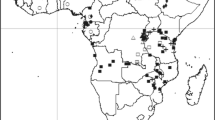Abstract
One of the most enigmatic and unusual groups in the passionflower genus, Passiflora section Dysosmia (Passifloraceae), stands out as a group that is notoriously taxonomically complicated. Phenetic and cladistic analyses of Dysosmia were carried out with representatives from all 21 species currently recognized in the section, in order to delineate morphological groups above the species level. The study was based mainly on vegetative morphological characters and included principal coordinates, non-metric multidimensional scaling, cluster, and cladistic analyses. Results from each analysis reveals that three major species assemblages exist within Dysosmia, corresponding largely to vegetative pubescence and fruit color. The results presented here set the stage for future systematic and phylogenetic studies in Passiflora sect. Dysosmia.








Similar content being viewed by others
Literature Cited
Feuillet, C. 2007. Folia taxonomica 1. Validation of two taxa from northern South America. Journal of the Botanical Research Institute of Texas 1: 143–144.
Feuillet, C. & J. M. MacDougal. 2003 [2014]. A new infrageneric classification of Passiflora L. (Passifloraceae). Passiflora: The Journal and Newsletter of the Passiflora Society International 13(2): 34–38.
Feuillet, C. & J. M. MacDougal. 2006. Passifloraceae. In: K. Kubiitzki (ed.), The families and genera of vascular plants, vol. IX: 270–281. Springer, New York City.
Givnish, T. J., K. J. Sytsma, J. F. Smith & W. J. Hahn. 1995. Molecular evolution, adaptive radiation, and geographic speciation in Cyanea (Campanulaceae, Lobelioideae). Pp. 288–337. In: W. L. Wagner & V. A. Funk (eds.), Hawaiian biogeography: Evolution on a hot spot archipelago. Smithsonian Institution Press, Washington, D.C.
Gower, J. C. 1966. Some distance properties of latent root and vector methods used in multivariate analysis. Biometrika 53: 325–338.
Hammer, Ø., D. A. T. Harper & P. D. Ryan. 2001. PAST: Paleontological statistics software package for education and data analysis. Palaeontologia Electronica 4(1). Downloadable from: https://folk.uio.no/ohammer/past
Killip, E. P. 1938. The American species of Passifloraceae. Publications of the Field Museum of Natural History, Botanical Series 19. Field Museum Press, Chicago.
Krosnick, S. E., K. E. Porter-Utley, J. M. MacDougal, P. M. Jørgensen & L. A. McDade. 2013. New insights into the evolution of Passiflora subgenus Decaloba (Passifloraceae): Phylogenetic relationships and morphological synapomorphies. Systematic Botany 38: 692–713.
Masters, M. T. 1871. Contributions to the natural history of the Passifloraceae. Transactions of the Linnean Society of London 27: 593–645.
Miller, R. J., T. Mione, H.-L. Phan & R. G. Olmstead. 2011. Color by numbers: Nuclear gene phylogeny of Jaltomata (Solanaceae), sister genus to Solanum, supports three clades differing in fruit color. Systematic Botany 36: 153–162.
Rambaut, A. 2014. FigTree. (Downloadable from: http://tree.bio.ed.ac.uk/software/figtree/).
Schneider, C. A., W. S. Rasband & K. W. Eliceiri. 2012. NIH Image to ImageJ: 25 years of image analysis. Nature Methods 9: 671–675.
Svoboda, H. T., J. M. MacDougal & H. E. Ballard. 2016. Typifications and nomenclatural notes in Passiflora section Dysosmia (Passifloraceae). Phytotaxa 288: 101–119.
Swofford, D. L. 2002. PAUP*. Phylogenetic analysis using parsimony (*and other methods). Downloadable from: http://paup.sc.fsu.edu
Vanderplank, J. 2013 [2014]. A revision of Passiflora section Dysosmia. Curtis’s Botanical Magazine 30: 317–387.
Acknowledgements
This paper is part of the doctoral dissertation of the first author. The project was supported in part by an Ohio University Graduate Student Senate Original Works Grant awarded to HTS. We are grateful to the directors of the MO, NY, and US herbaria for kindly providing access to their collections and for loans of specimens, as well as three anonymous reviewers who helped improve this manuscript. We further extend our thanks to John MacDougal for creative insights and guidance throughout the project.
Author information
Authors and Affiliations
Corresponding author
Rights and permissions
About this article
Cite this article
Svoboda, H.T., Ballard, H.E. Phenetic and cladistic studies help clarify species assemblages in Passiflora section Dysosmia (Passifloraceae). Brittonia 70, 15–24 (2018). https://doi.org/10.1007/s12228-017-9495-z
Published:
Issue Date:
DOI: https://doi.org/10.1007/s12228-017-9495-z




